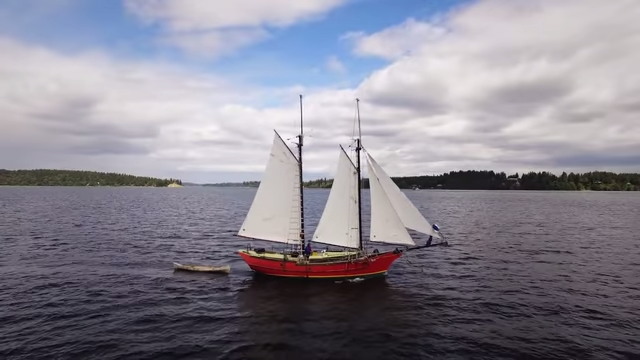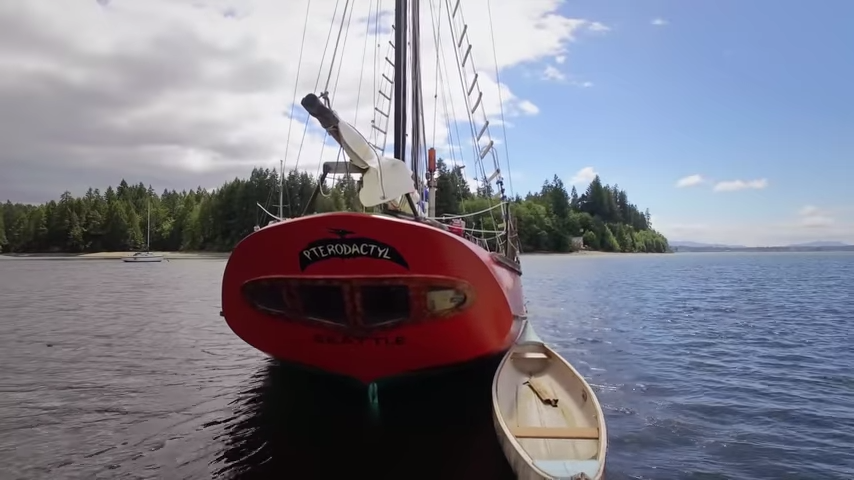Artist Builds SAILBOAT from CONCRETE, The Pterodactyl, a Gaff Rig Schooner
This is the schooner Pterodactyl, built by Edwin Landis, but people in the sailing community know him as Eddie, and now that he has his captain's license, so he guesses he can be Captain Eddie. The Pterodactyl has a 42-foot JR Benford design concrete haul. Everything else is wood. He always liked boats and built his first boat at about eight, but it wasn't quite the right shape. No adults told him anything about it. He was just building it and he thought that wood floated so it would float. He didn't know about displacement or any of that. The neighborhood was like "Eddie's going to launch his boat", so he put it on his back and took it down to the river. His mother made him a little bag of lunch and there were others and the neighbors were down there and everything and he said, "okay he’s gonna take it out a little ways to come back and then he’ll give everybody rides." And he stepped in it and instantly went right to the bottom, he was up to his knees or so in the water standing by. That was his first boat, and his second boat he could bail if he had another kid with him he could bail fast enough to keep it afloat and then he took it home and wrapped an old shower curtain around it and it didn't leak any more. It was great, so he was always into boats, loved boats, and building shacks and stuff.
This is a schooner rig that he’s built himself. It has a midships cockpit, after the cockpit the deck comes up a little bit and continues back to the stern. His boat has lazy jacks so that when he lowers the sail it catches it, which saves a lot of work. He didn't learn boating from being with real boaters. He did it from books or just himself so he doesn't necessarily use all the terms or do things conveniently, but that’s part of the charm of his operation. He made the masts of Sitka Spruce, unlike most people which use Douglas Fir, which is very strong. Eddie says Sitka Spruce is just as strong but way lighter. He has his air-cooled diesel engine instead of having water cooling like regular yachts. The engine room's right underneath there so he got this little light. Every steel fitting is homemade. It's got like a chain in there it's all stuff that he made so it's a little crude, but functional.
He has a hydraulic drive that can creep when he goes in neutral. Because of this, he has to put a brace when he puts it in neutral so when he’s doing something all of a sudden it's isn’t in gear full bore. With the air-cooled engine it has to have good cool air going in. He thinks in the catalog traditional bronze air scoops are worth hundreds of dollars, so he just went to Lowe's and got some PVC.
Eddie gets a lot of inspiration from Tommy Drake, a retired captain who built his own boats. They call him The Lone Sea Rover and he didn't set records, he just sailed and he built his boats, everything: designed and built them. They're fairly crude in some ways, but functional good boats. Because of this, Eddie decided to name his club after Tommy Drake. That whole attitude with making it seaworthy functional, use what you got, and go out there. It's the Drake attitude and if something is Drakeish well, it's functional and unpretentious and if you think like that you're a Draker.
By having a Schooner Rig with four working sails and he can put two other sails up it divides the square footage in so no sail has to be so big that it's unmanageable. There's no winches on Eddie’s boat. When you see Popeye the cartoon he has those oversized forearms, and there's a reason for that. Sailors are always gripping and pulling, at least the old-fashioned ones, and they have unbelievably big forearms because of that. He has a hundred pound fisherman anchor, which is unwieldy, but it holds. To bring it in he has a 6-ton logging winch that he got secondhand.
He started building in about 1973. He was with his brother Davi his wife at the time. They built the boat shed first, that took over a month although he had built lots of boats as a kid, he didn't really know even how to read boat prints or any of that. He sent his money in, a tube of blueprints came in the mail with all the lines and details and stuff but no instructions whatsoever. He had to get every book he could find. A year later in March it was ready for plastering. This was the tricky part. While you can build the steel armature perfectly, if you don't have it plastered right you're screwed. Nobody's building boats the way Eddie did anymore because it has a reputation and not much resale value since a lot of people did such a poor job building them this way. But Eddie's boat is holding up fine, so he’s happy with it.
His galley has an old Washington Stove Works Neptune 15a which has an oven. He got this alcohol stove and made gimbals. You can buy a gimbal sink for a hundred bucks so when the boat's tilted the stuff on the stove stays level.
His drawers are designed to fit in notches that keep them from sliding open when under way. To open them, you simply lift them up slightly. He had an interval water tank and he didn't like so he took it out. The sink also has a foot pump, but he has to make a new one. The table you can pull the pin and make it go down and you got a double berth there but he couldn't get pipes that fit really snug, so he’s gonna have to pad out the one pipe.
Up at the front, which is a catch all right now, is the fo'c'sle. It's got a double berth for a couple. And then he also has a single berth, under which he stores ground tackle.
The boat has a head, or bathroom, which is complete with a composting toilet. You put peat moss in it, crank it 15 times, and that's how you flush it. The aft cabin with it’s double berth is really really nice, it even has a wood stove that he welded himself. Cables go through tubes underneath the bed that controller the steering.
Eddie really likes the adventure that sailing makes even relatively short distances. Time is way different. It's just a different perspective and it's helpful. His advice for people wanting to do something similar is to just start. If you could boil it down that's that's it. Just try. Just start. You can not have your exact plan for the rest of your life. You just have to start and that's the way he has done everything. It might be a risk, but that’s what makes it worth trying.
Watch the Full Video Here:







